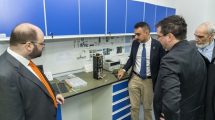 O3b’s first four Ka-band satellites were launched into orbit on June 25 from French Guiana. Launches are always exciting for the industry, but as the lead up to this one caused extra anticipation, the occasion was even more thrilling. O3b’s successful blast-off only happened on the second take. High winds saw its first scheduled launch on June 24 delayed for 24 hours, causing many around the world to anxiously watch the time to count-down tick away the following day.
O3b’s first four Ka-band satellites were launched into orbit on June 25 from French Guiana. Launches are always exciting for the industry, but as the lead up to this one caused extra anticipation, the occasion was even more thrilling. O3b’s successful blast-off only happened on the second take. High winds saw its first scheduled launch on June 24 delayed for 24 hours, causing many around the world to anxiously watch the time to count-down tick away the following day.
Lift-off: in the evening of June 25, the Arianespace Soyuz launch vehicle roared into the sky. A few hours later, O3b’s gateway in Hawaii received confirmation that the four birds were successfully in their middle earth orbit (MEO) locations.
An addition to the constellation is scheduled for September, when the second four satellites are to be launched, says Steve Collar, CEO of O3b, adding that more sky birds are to be added in 2014.
“Full service operations is planned for November 2013. O3b has the ability to deploy more satellites to meet market demand.”
O3b success will have an impact on the Middle East and Africa. The company name stands for the “other 3 billion”, referring to the collective number of people from Latin America, Africa, the Middle East, Asia and the Pacific, who aren’t afforded regular access to the internet. O3b’s mission is to provide these people state-of-the-art broadband service; higher capacity and lower latency.
Approximately 20% of trunking across Africa and the Middle East is delivered via standard geostationary satellites. Not only does O3b claim to offer lower costs, but it will solve some of the latency issues associated with geostationary earth orbit (GEO) satellites.
“The network was designed to avoid much of the difficulty that satellite connectivity provides today, which is this delay,” says Collar. “We wanted to fix those problems and the only way to fix them is to bring the satellites closer to Earth.”
What would the cost be for a new, local IP service provider? This depends on the amount of capacity selected and the equipment used, says Collar.
“But it is reasonable to assume that the costs for capacity will be 30-50% less than comparable GEO satellite services. The cost of the terminal equipment will be higher because two antennae are required to track the constellation, but the payback period is short because the service cost is so much lower.”
The target market in the region includes internet service providers – the latency is less than 150 milliseconds – and the telco, enterprise and government verticals, says Collar, adding that O3b is ideal for remote and deep-sea areas.
“There is a great market opportunity in the Middle East to serve internet connectivity for remote areas that are not fibred, affordable extension of 3G and 4G mobile services and oil, gas and mining operators in remote or deep-water locations. In many cases, the arrival of fibre to urban areas fuels the demand for high-speed data services where terrestrial fibre is not feasible or affordable. These will be key growth targets for O3b”
O3b will have all landing rights in the GCC region to serve its customers at the time of service commencement, says Collar.
“The offer of affordable, high-speed, low-latency connectivity will benefit [the] education and health [sectors] and foster economic growth in areas that have limited or no broadband connectivity. Such technology supports the GCC charter to stimulate scientific and technological progress in the fields of industry, mining, agriculture, water and animal resources; to establish scientific research; to establish joint ventures and encourage cooperation by the private sector for the good of their peoples.”
The MEO satellites are Ka band and while rain isn’t a concern in the Middle East, it is prevalent in the other targeted markets. However, O3b has provided a solution for this, says Collar.
“Ka band is subject to rain fade in very wet areas [but] O3b systems are designed with appropriate equipment to deliver desired availability and use adaptive coding and modulation to ensure that the highest possible throughput is achieved at all times. In some cases, a hybrid solution may be used so that the currently installed C band may be used as a back-up during brief periods of heavy rain.”
O3b stayed on the conservative end while estimating its satellites’ lifetime, explains Collar.
“Typical life for a MEO satellite would be about 12-15 years. We have made a conservative estimate of 10 years, but our testing indicates that satellite life is likely to be closer to 12 years. Power produced from the solar panels will define satellite life. Each satellite has sufficient fuel for several lifetimes.”














Add Comment